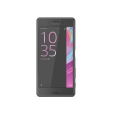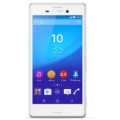- Home
- List of devices
- Sony
- Sony Xperia Z1 Compact
Sony Xperia Z1 Compact
-
CPU:
-
RAM:
-
Storage:
-
Display:
-
Camera:
-
OS:
The Xperia Z1 Compact is everything you expect in a premium smartphone, beautifully crafted to fit perfectly in the palm of your hand. Capture stunningly beautiful photos and videos using the same technology as featured in our compact digital cameras. Easily move all your valuable content from your smartphone to your new Xperia Z1 Compact with Xperia™ Transfer. Best of all, the Xperia Z1 Compact is waterproof* and comes in a range of colours.
The Xperia Z1 Compact from Sony comes with a handy 4.3(10.92 cm) display that’s just the right size, making it the perfect smartphone for anyone who’s always on-the-go. It’s elegant, slim and simply melts into your hand.
The Xperia Z1 Compact has been carefully crafted using only premium materials and clean lines. It’s built with a solid one-piece aluminium frame that creates a completely seamless expression, and the screen is made of durable tempered glass that reflects the world around you. And following Sony’s unique design principles, this NFC phone offers balance and symmetry in all directions, so no matter how you’re holding it the feeling is always the same.
Sony Xperia Z1 Compact featuring a camera as good as compact digital cameras by Sony, this advanced camera phone comes with Superior Auto. This default camera setting recognises up to 36 scene types and adjusts the settings automatically, so you can get the best photos, anywhere and at any time. So sit back, enjoy the moment and let your Xperia Z1 Compact do the thinking for you.
The world’s best camera in a waterproof compact smartphone, funny faces underwater. Beautiful scenery. Or the graceful brushstrokes on a hand painted vase. The Xperia Z1 Compact combines a large 1/2.3(1.10 cm) 20.7 MP Exmor RS™ for mobile image sensor, Sony’s award-winning G Lens and the intelligent BIONZ™ for mobile image-processing engine. For pictures that are sharp, blur-free and absolutely stunning.
Specs
General
| Announced | 01 January, 2014 |
| Released | 01 January, 2014 |
| Status | Available |
Display
| Display Type <strong>Display Technology => </strong> A number of display technologies and types used in mobile phones => TFT (Thin Film Transistor), IPS (In-Place Switching), OLED (Organic Light Emitting Diode), AMOLED (Active-Matrix Organic Light-Emitting Diode), Super AMOLED (an even advanced version of AMOLED), Resistive Touchscreen (Resistive touchscreens contain two layer of conductive material with a very small gap between them which acts as a resistance), Capacitive Touchsceen (Capacitive touchscreen technology consists of a layer of glass coated with a transparent conductor) | IPS LCD |
| Size | 4.3 inches |
| Resolution | 720 x 1280 pixels |
| Pixel Density <strong>Pixel Density (PPI)</strong> is refers to the concentration of pixels on a particular display, measured in pixels per inch (ppi). Pixel density is calculated by dividing the diagonal pixel resolution of a display by its diagonal size, higher pixel density better display quality. | 342 ppi pixel density |
| Display Protection <strong>Display Protection => </strong> Gorilla Glass is a special alkali-aluminosilicate glass shield with exceptional damage resistance that helps protect mobile displays from scratches, drops, and bumps of everyday use, It is always better to go for a smartphone with Gorilla Glass for that added protection and peace of mind. | Shatter proof glass |
| Features | Multitouch up to 10 fingers, Triluminos display, X-Reality Engine |
Hardware
| Chipset <strong>Chipset</strong> is a group of integrated circuits designed to perform one or a more dedicated functions, often with real time computing constraints, Popular smartphones are equipped with more advanced embedded chipsets that can do many different tasks depending on their programming. | Qualcomm MSM8974 Snapdragon 800 |
| CPU <strong>CPU</strong> (Central Processing Unit) mostly known as processors, CPU processes instructions in order to carry out certain functions that make your device operate properly. Processors are often described as the brain of computers, smartphones and tablets, Smartphones and tablets rely on processors to carry out their every task, Processors are an incredibly important factor in selecting any type of computing device, including your smartphone. | Quad-core 2.2 GHz Krait 400 |
| GPU <strong>GPU</strong> (Graphics Processing Unit) is a single-chip processor designed to rapidly manipulate and alter memory to accelerate the creation of images in a frame buffer intended for output to a display, This includes things such as lighting effects, object transformations, and 3D motion. | Adreno 330 |
| RAM (Memory) <strong>RAM</strong> (Random Access Memory) is a type of computer memory that can be accessed randomly, any byte of memory can be accessed without touching the preceding bytes that allows information to be stored and accessed quickly from random locations. RAM is the most common type of memory found in computer systems, smartphones, tablets and other electronic devices. | 2 GB |
| Internal Storage <strong>Internal Storage</strong> is a data storage space (flash memory) mostly used in smartphones, tablets and other electronic devices where operating system, apps, music, photos, videos, files and other user data Is stored. | 16 GB |
| Card Slot <strong>Memory Card Slot</strong> is a special slot for inserting a memory card. Memory cards allow you to expand the phone's built-in memory, A memory card (sometimes called a flash memory card or a storage card) is a small storage medium used to store data such as text, pictures, audio, and video, for use on small, portable or remote computing devices such as mobile phones, mp3 players, digital cameras. | Yes, microSD, up to 64 GB |
| Sensors <strong>Sensors</strong> are electronic components that detects and responds to some type of input from the physical environment. The specific input could be light, heat, motion, moisture, pressure and location, The output is generally a signal that is converted to use in computing systems, a location sensor, such as a GPS receiver is able to detect current location of your electronic device. | Accelerometer, gyro, proximity, compass |
Battery
| Battery Type <strong>Battery Type => </strong> Cell phones run on various kinds of batteries depending on the manufacturer, phone size or shape and features. There are basically four types of cell phone batteries => Lithium Polymer, Lithium Ion, Nickel Metal Hydride and Nickel Cadmium. | Li-Ion (Lithium Ion) |
| Capacity <strong>Battery Capacity</strong> is a measure (typically in Amp-hr) of the charge stored by the battery, and is determined by the mass of active material contained in the battery. The battery capacity represents the maximum amount of energy that can be extracted from the battery under certain conditions. | 2300 mAh |
| Standby <strong>Standby Time</strong> is the total amount of time that you can leave your is fully charged, turned on and ready to send and receive calls or data transmissions before completely discharging the battery. | Up to 670 hrs (2G) / Up to 600 hrs (3G) |
| Talk Time <strong>Talk Time</strong> is the longest time that a single battery charge will last when you are constantly talking on the phone under perfect conditions, Ambient temperature and highly dependent on the cellular network environment such as the distance to the closest cell network tower. | Up to 10 hrs (2G) / Up to 18 hrs (3G) |
Camera
| Primary <strong>Camera</strong> is able to capture photographs and usually videos, The most important characteristics of a camera are the resolution (measured in megapixels), lens focus type (fixed or automatic), higher megapixel cameras are known to capture higher quality photos, but not always a good measurement of the photos quality. | 20.7 mega pixels |
| Camera Features | 1/2.3'' sensor size, geo-tagging, auto focus, touch focus, face detection, image stabilization, HDR, panorama |
| Secondary | Yes, 2 MP, 1080p@30fps |
| Image | 5248 х 3936 pixels |
| Video | Yes, 1080p@30fps, HDR |
| Flash <strong>Flash Light => </strong> There is commonly two types of flash lights are used in camera mobile phones, LED Flash (LED flash offers lower power consumption with drive circuitry that takes up very little room, LEDs can be strobed faster than any other light source), Xenon Flash (xenon flash produces an extremely intense full-spectrum white light for a very short duration) | LED flash |
Design
| Type <strong>Design Type</strong> called form factor refers to a mobile phone's size, shape, and style as well as the layout and position of major components of phone. There are three major form factors seen in mobile phones => bar phones, folding phones and sliding phones. | Bar |
| Dimensions | 127 x 64.9 x 9.5 mm (5.0 x 2.56 x 0.37 in) |
| Weight | 137 grams (4.83 oz) |
| Protection | IP58 certified - dust proof and water resistant over 1.5 meter and 30 minutes |
| Colors | Black, White, Pink, Lime |
Network
| SIM <strong>SIM</strong> (Subscriber Identity Module) is a small card that contains mobile network subscriber's account information. This allows the phone using the card to attach to a mobile network. The SIM card is most commonly associated with GSM and UMTS mobile networks. Moving a SIM card from one phone to another allows a subscriber to switch mobile phones without having to contact their mobile network carrier. SIM cards can also be used by a phone to store limited amounts of data, such as phone numbers and text messages. | Micro SIM |
| Dual SIM | No |
| 2G Network | GSM 850 / 900 / 1800 / 1900 |
| 3G Network | HSDPA 850 / 900 / 1700 / 1900 / 2100 |
| 4G Network | LTE 800 / 850 / 900 / 1700 / 1800 / 1900 / 2100 / 2600 |
Software
| Operating System <strong>OS => </strong> Every computer system run on a base software called Operating System (OS). Operating System controls all basic operations of the computer (such as smartphone, PDAs, tablet computers and other handheld devices). The Operating System allows the user to install and run third party applications (apps), apps are used to add new functionality to the device. | Android v4.3 (Jelly Bean), upgradable to v4.4.4 (KitKat) |
| User Interface <strong>UI</strong> or user interface of a device is the look and feel of the on-screen menu system. How it works, its color scheme, how it responds to button presses, all of these things are part of the user interface. | Sony UI |
Connectivity
| Bluetooth <strong>Bluetooth</strong> is a wireless communications technology for exchanging data between mobile phones, headsets, computers and other network devices over short distances without wires, Bluetooth technology was primarily designed to support simple wireless networking of personal consumer devices. | Yes, v4.0, A2DP |
| Wi-fi <strong>Wi-Fi</strong> is a popular wireless networking technology using radio waves to provide high-speed network connections that allows devices to communicate without cords or cables, Wi-Fi is increasingly becoming the preferred mode of internet connectivity all over the world. | Wi-Fi 802.11 a/b/g/n/ac, dual-band, Wi-Fi Direct, DLNA |
| USB | Yes, microUSB v2.0 (MHL), USB On-the-go |
| GPS <strong>GPS</strong> The Global Positioning System is a satellite-based radio navigation system, GPS permits users to determine their position, velocity and the time 24 hours a day, in all weather, anywhere in the world, In order to locate your position, your device or GPS receiver must have a clear view of the sky. | Yes, with A-GPS, GLONASS |
| NFC <strong>NFC</strong> (Near field communication) is a set of standards for smartphones and similar devices to establish peer-to-peer radio communications with each other by touching them together or bringing them into proximity, usually no more than a few inches. |


